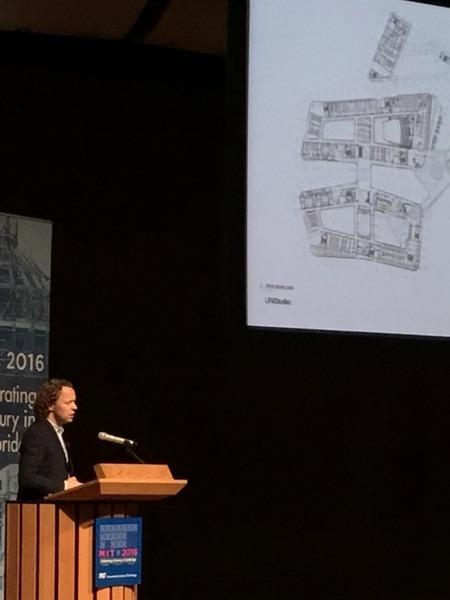Celebrating the Genius of Connected Corridors
-
-
slice.mit.edu
- 1
Filed Under

Recommended
Caption: Architect Christian Veddler describes the importance of the diagonal corridors that link indoor and outdoor spaces at the Singapore University of Technology and Design, which was developed in collaboration with MIT.
A key theme of MIT’s 1916 campus centennial celebrations is how the founding building itself contributed to the core of MIT’s way of being, learning, and building community. At the March 30-31 conference, Designing Places for Inventing the Future: The Campus—Then, Now, and Next, the speakers probed factors such as the innovative use of reinforced concrete as a building material. Yet the lead idea is not materials but how connected buildings unify people and ideas.
“'Architecture is your destiny' is a phrase that could describe our 1916 building,” says Professor Mark Jarzombek, who also noted that MIT’s Bosworth building, also called the Main Group, was the largest concrete structure in the world at the time. The large, unified building topped by a massive dome offered a monumental face to the City of Boston, and its corridors connected academic spaces and student residences. The architecture plan itself promoted frequent conversations among faculty and students in different disciplines and promoted a community of learning.
“The academic corridor was a kind of compression zone…You could meet the president, faculty, and students for discussions. It was designed as a social connection,” says Jarzombek.
The conference also pointed to similar principles in contemporary academic buildings with MIT connections such as the Skolkovo Innovative Center near Moscow and the Singapore University of Technology and Design.
Architect David Adjaye, who will serve a campus residency at MIT this spring as a McDermott Award in the Arts winner, designed the Moscow School of Management Skolkovo, located near a graduate university established in collaboration with MIT. Adjaye created a circular central building, about 1,000 feet in diameter, that houses classrooms on the edges, collaborative and community space in the center, and four buildings constructed on top to provide student housing, a recreation center, a hotel, and offices. The central disk, the heart of the school, serves the needs of a dense community by means of “infinite corridors” that connect everyone in the community.
Another architect, Christian Veddler, presented his design for connected buildings of the Singapore university headed by Institute Professor Thomas Magnanti, who serves as president, and was developed in collaboration with MIT. Veddler used linked, diagonal corridors to connect the buildings and natural gathering places. Outside, the corridors also run along the perimeters of the buildings to create a permeable façade that is “always open, shaded, and naturally ventilated.” Corridors unite people and create meeting places suitable for a tropical climate.
In a session on the Virtual Campus, MIT Vice President for Open Learning Sanjay Sarma asked a pivotal question: “In an era of MOOCs and global learning, what does it mean to be on campus?” While the campus environment remains special, he says, “teams, ideas, and peer learning happen both on site and online. For many, online creates opportunities that would otherwise not be available.”
Anant Agarwal, CEO of edX, said education needs to learn to innovate faster to keep people continuously learning while they are employed or otherwise engaged. He noted that MIT’s new Micromaster’s Credential in Supply Chain Management is a step toward flexible, continuous learning.
Learn more about the conference, Designing Places for Inventing the Future and upcoming events, such as the April 12 symposium Beyond 2016—MIT's Frontiers of the Future (register online by midnight!) and May 7 Moving Day festivities, that are part of MIT 2016: Celebrating a Century in Cambridge.








Comments
Emil M Friedman
Wed, 11/23/2016 1:35pm
We all passed under the great dome quite a few times per week. That made it a perfect spot for any activity group to attract new members and/or espouse their views. I doubt that any sort of "normal" campus had anything that served that purpose. (My mother wanted me to go to a school with a "normal campus" so I biased my choices for recommendations to make MIT more likely to admit me and other colleges less likely. Then I had to tell my college advisor not to call someone he knew at Cornell when they put me on their waiting list.)